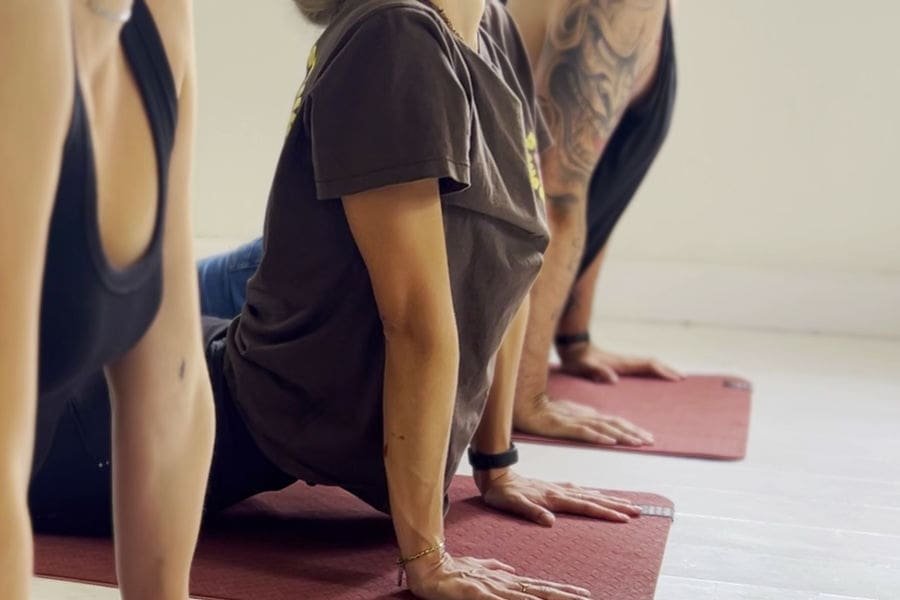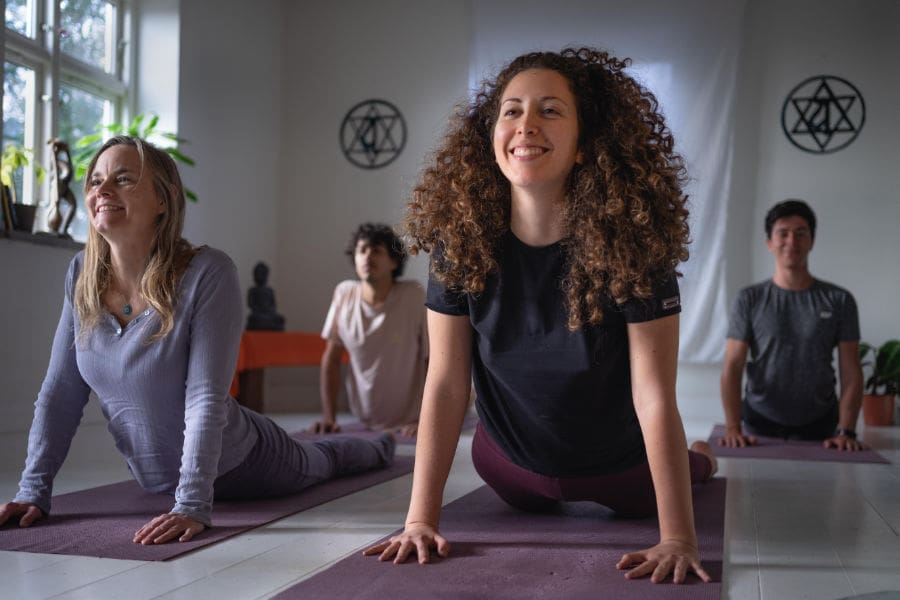Vagus Nerve Yoga reduces anxiety and is profoundly relaxing. Regular practice lowers stress hormones, boosts the immune system and improves sleep. You will will look and feel happier and more radiant.
Get To Know Your Vagus Nerve
Practicing yoga has been shown to activate the vagus nerve, which can result in significant health benefits.
To experience these benefits, be sure to read through to the end. This blog will help you understand how practicing vagus nerve yoga can improve your wellbeing, it might even inspire you to get on the yoga mat start practising!
Learn how to relax
Learning how to activate my vagus nerve was a life changer. I was able to use stress positively even when engaged in difficult tasks. Equally important, I could activate my relaxation response.
The vagus nerve is central to wellbeing as it regulates the vital organs in the body. It controls your breath, heart rate, digestion and gut health. A sluggish or inactive vagus nerve can lead to chronic health issues.
Recent research even suggests that activating your vagus nerve is linked to feelings of love and compassion. Being in a beautiful place (and especially with someone you love) actually helps tone your vagus nerve. Wow! And this in turn, helps you to connect more deeply with each other. It’s a positive feedback loop for love!
The Mind Body Connection
This research has uncovered a key element of how mind and body interact. One that may help explain the beneficial effects of yoga. Named after the Latin word for “wandering” (vaga, like vagabond), the vagus nerve is a major bundle of nerves running the length of the body. It controls our internal processes, our response to stimuli and even our mood.
The vagus nerve serves as a messenger between your body and brain. It connects the brain with all major organs, and monitors what is going on in the body. Anything that affects the vagus nerve affects your wellbeing, emotions, behavior, sleep, even your ability to concentrate.
Yoga postures that work on the vagus nerve have a positive effect on things such as vitality, mental peace, balance, immunity, and relief from anxiety and depression.
The system of yoga including, asanas, breathing techniques and meditations, is known to profoundly affect mood and physical health. We now know that these ancient practices are working to activate the vagus nerve.

Master Stress With Vagus Nerve Yoga
The stress of a fast-paced career takes a heavy toll on your wellbeing. So, it is vital to manage your vagus nerve when facing deadlines, important meetings, and big decisions. Sometimes, we need to perform our best even when we feel at our worst.
What if there was a way to flip the script and regain control over stress? This is exactly what yoga for the vagus nerve can do for you.
Vagus nerve yoga puts you in control of stress, not the other way around. When the vagus nerve is active and toned, it keeps you balanced and relaxed. It also increases attention span, improves emotional resilience and makes you happy.
Understanding how yoga practices activate the vagus nerve has not only deepened my personal practice, it has delivered profound benefits to the yoga students passing through Yogi Living Retreat Center. It is now one of the core elements of my Prana Yoga teaching, due to it’s deeply relaxing and healing effect.
Tantric Breathing Releases Anxiety and Stress
Try this easy Tantric breathing method to quickly activate your vagus nerve:
- Sit in a relaxed position with relaxed shoulders and a straight spine.
- Close your eyes and take a few deep breaths.
- Imagine your breath flowing into your heart as you inhale, filling it with calm and relaxation. Then re-inhale and imagine your heart expanding.
- As you exhale, visualize the energy traveling up through the center of your body to the crown of your head. Then exale the last air and imagine the energy dispersing over the crown of your head.
- Repeat this process several times, focusing on the connection between your breath and your body.
I have used this technique to instantly alleviate stress and anxiety in my clients.
Use it or lose it
Modern life can put us in many stressful situations. When the body is regularly in a state of stress, or for long periods of time, it crushes your health. In such cases the “fight or flight” response becomes permanently switched on by default. Relaxing becomes near impossible. This is a big problem because your body, brain and organs need time to recover from stress. Vagus nerve yoga reverses this situation.
When the vagus nerve is at a low level of activity, you may notice various mental and physical issues. You may have dizziness or mental fog, problems managing your emotions, and feelings of anxiety or depression. An inactive vagus nerve can weaken your immune system. It can cause cardio-vascular problems such as irregular heart rate, high blood pressure, or hypertension. Digestive issues like IBS, heartburn, and constipation may develop, even obesity and eating disorders.
An inactive vagus nerve can cause chronic inflammation, pain and autoimmune diseases. In severe cases it may even cause cancer. Chronic stress also accelerates aging.
It is time to reset your mind-body connection and activate your vagus nerve with vagus nerve yoga!

Tone Your Vagus Nerve
While many believe stress should be countered or “released” with high-energy workouts, the opposite is actually more effective. Exhausting the body can stimulate the vagus nerve, but heavy workouts can also stress the system further.
With its focus on physical postures and breath awareness, yoga has proven an effective way to activate the vagus nerve. Twisting asanas are particularly effective. This explains how reverse triangle pose helps with hypochondria. Until I learned about the vagus nerve this connection was always a mystery for me!
So, what does that look like? Here are the main ways to activate your relaxation response with vagus nerve yoga:
We are not talking power yoga or hot yoga, which can be stressors on the body. What works best is simple yoga asanas performed mindfully. Hatha or Yin Yoga are the perfect fit for activating the vagus nerve, with their slow-pace and emphasis on stillness.
Hatha yoga in the mornings provides strength, calmness and focus throughout the day. Mindful and slow-paced yoga, with inhalation and exhalation for at least five seconds is ideal. Asanas held for nine breaths or more, further increase vagal activation.
Yin yoga emphasizes mindfulness, deep breathing, and prolonged poses, and stands out as the most effective yoga form for activating the vagus nerve.

Sun salutation (Surya Namaskara) is in my opinion, a core practice for vagal toning. It should be practiced slowly with attention on the breath. Additionally, Sun Salutation elongates and de-compresses the spine, massaging nerve connections along the vagal pathway.
My students love sun salutation when practiced at its deepest (=most vagus activating) level. Practising in a very meditative flow state is an entirely new experiencefor them! See my blog: Sun Salutation As An Active Meditation.
Mantra chanting slows down the breath and activates the vocal chords, amplifying the effect of each on the vagus nerve. AUM chanting, in particular, strongly vibrates the vocal cords and thyroid, which helps balance hormones.
There is a reason why singing makes you feel happy — it activates the vagus nerve! If you do not want to chant mantras, singing or humming also will have a positive effect.
Meditation calms the mind and puts attention on the breath. This, in turn, activates the relaxation response. Meditation even changes structures in the brain and is observed to increase whole brain functioning.
Individuals who may find meditation too difficult may benefit from dynamic meditations which involve music and movement. These actually are excellent adjuncts to quieter forms of meditation.
Pranayama literally means controlling the life force energy. There are many kinds of pranayamas. Nadi Choaden and Bhramari are very good for toning the vagus nerve, and are deeply relaxing for body and mind.
Energizing forms such as Kapalabhati and Bhastrika are also beneficial, but tend to be more activating. If you have high blood pressure, you should opt for the slower and more calming pranayamas.

Laughter has been used as a meditative practice since the time of the Buddha. Laughter yoga activates the vagus nerve at multiple points: brain, vocal chords, kidneys, and belly.
Did you know laughter is healthy? Laughter improves cognitive function, is rejuvenating and helps prevent heart disease.
Yoga Nidra, also called Sleep Yoga, is known to improve quality of sleep. It does so by, can you guess? Yes, it activates the vagus nerve! Practiced just before bedtime it is an antidote to insomnia, and requires very little effort (just lie back and enjoy the journey).
Yoga Nidra uses visualization which not only relaxes mind and body, but has the power to heal unhealthy mental habits. It also lowers heart rate, blood pressure, and is particularly effective for releasing anger. Best practiced at night, after work, or when you first wake up in the morning.
The intentional movement of Kundalini energy uses slow and mindful breathing, which also activates the vagus nerve. This explains the deeply calming effect of Kundalini Yoga Kriyas.
There is a close correlation between the location of the chakras and, endocrine glands and vagus nerve, which is interesting though unproven. Read more about this in the my blog: The Vagus Nerve And Chakras.
Your vagus nerve is the body's internal compass, guiding you from stress to calm and from tension to tranquility.
A Path To Better Health
Vagus nerve yoga creates a state of calm and balance within the body, and supports mental and physical health. You will feel more grounded in the body and this helps you more easily navigate life’s demands.
Here are some of the many health benefits of an active vagus nerve:
1. Improved Mental Health
Higher vagal tone is associated with improved emotional regulation, reduced anxiety, and resilience to stress. It balances the autonomic nervous system, promoting mental wellbeing.
2. Better Heart Health
Helps maintain a steady heart rate and reduces the risk of arrhythmias. Supports healthy blood pressure levels by enhancing the body’s ability to regulate blood flow.
3. Enhanced Immune Function
Strengthens the body’s ability to fight infections by regulating the production of anti-inflammatory cytokines. Modulates the immune response to reduce chronic inflammation, which is linked to conditions such as arthritis, asthma, and autoimmune diseases.
4. Reduced Stress And Anxiety
Vagal stimulation helps decrease the production of cortisol, the body’s primary stress hormone, leading to reduced feelings of stress and anxiety. Activates the parasympathetic nervous system, promoting a state of calm and relaxation.
5. Improved Digestion
Stimulates the release of digestive enzymes, improving the breakdown and absorption of nutrients. Promotes peristalsis, the wave-like muscle contractions that move food through the digestive tract, reducing symptoms of constipation and bloating.
6. Better Sleep
Promotes the transition into deeper stages of sleep, improving overall sleep quality and duration. Helps regulate sleep-wake cycles, reducing insomnia and creating a more consistent sleep pattern.
7. Reduced Inflammation
Vagus nerve stimulation reduces production of pro-inflammatory cytokines, decreasing chronic inflammation linked to health conditions such as cardiovascular disease and diabetes.
8. Stress Resilience And Emotional Control
Improves the body’s ability to return to a state of calm after a stressful event.
Supports better control over emotional responses, reducing the impact of stress on mental and physical health.
9. Improved Mood And Emotional Stability
Affects the production and regulation of neurotransmitters like serotonin and dopamine, which play key roles in mood regulation. Higher vagal tone has been associated with lower incidence of depression and better response to treatment.
10. Better Speech And Singing
A well-toned vagus nerve supports the vocal chords, improving pitch and volume control, reducing hoarseness for a clearer and more consistent voice. It regulates vocal cord tension, reducing strain and promoting effective articulation.
Knowing how to activate your vagus nerve can deliver numerous health benefits, and an improved sense of wellbeing. Stimulating the vagus nerve promotes calm and balance within the body, and supports mental and physical health.
Summary
Current research recognizes that a well-toned vagus nerve is essential for emotional, mental, and physical wellbeing. The vagus nerve regulates the vital organs in the body. It controls your breath, heart rate, digestion and gut health. Vagus nerve yoga puts you in control of stress, not the other way around. When the vagus nerve is active and toned, it keeps you balanced and relaxed.
Yoga that works on the vagus nerve has a positive effect on vitality, mental peace, balance, immunity, and anxiety and depression. After my yoga classes for vagus nerve activation, students leave with a deep sigh, having shed many layers of stress. They are deeply relaxed, some even describe feelings of euphoria.
The simply daily practice of vagus nerve yoga is an antidote to stress. Modern research on the vagus nerve validates this. Furthermore, it explains how yoga heals and relaxes, as well as why some practices complement each other. Yoga for the vagus nerve can improve the quality of your life and put a smile on your face that can last all day.
2025
Prana Healing Retreat
Our Prana Healing Retreat is designed to nourish your soul and revitalize your body. Walk white sand beaches, swim in the Baltic Sea, and find deep peace. Leave refreshed, rejuvenated, and reconnected with your inner self.
References
- Sullivan MB, Erb M, Schmalzl L, Moonaz S, Noggle Taylor J and Porges SW (2018) Yoga Therapy and Polyvagal Theory: The Convergence of Traditional Wisdom and Contemporary Neuroscience for Self-Regulation and Resilience. Front. Hum. Neurosci. 12:67. doi: 10.3389/fnhum.2018.00067
- GROSSMAN, P. and KOLLAI, M. (1993), Respiratory sinus arrhythmia, cardiac vagal tone, and respiration: Within- and between-individual relations. Psychophysiology, 30: 486-495. https://doi.org/10.1111/j.1469-8986.1993.tb02072.x
- Bassam Khoury, Manoj Sharma, Sarah E. Rush, Claude Fournier, Mindfulness-based stress reduction for healthy individuals: A meta-analysis,
Journal of Psychosomatic Research, Volume 78, Issue 6,
2015, Pages 519-528, ISSN 0022-3999, https://doi.org/10.1016/j.jpsychores.2015.03.009. - Pascoe, M. C., Thompson, D. R., Jenkins, Z. M., and Ski, C. F. (2017). Mindfulness mediates the physiological markers of stress: systematic review and meta-analysis. J. Psychiatric Res., 95, 156–178.
- Gerritsen RJS and Band GPH (2018) Breath of Life: The Respiratory Vagal Stimulation Model of Contemplative Activity. Front. Hum. Neurosci. 12:397. doi: 10.3389/fnhum.2018.00397
- Somere K, Munkevics M, Krams R, Rača G, Luoto S and Krams I (2024) The effect of yin yoga intervention on state and trait anxiety during the COVID-19 pandemic. Front. Psychiatry 15:1345455. doi: 10.3389/fpsyt.2024.1345455
- C.C. Streeter, P.L. Gerbarg, R.B. Saper, D.A. Ciraulo, R.P. Brown, Effects of yoga on the autonomic nervous system, gamma-aminobutyric-acid, and allostasis in epilepsy, depression, and post-traumatic stress disorder, Medical Hypotheses, Volume 78, Issue 5, 2012, Pages 571-579, ISSN 0306-9877, https://doi.org/10.1016/j.mehy.2012.01.021.
- Kaviraja Udupa, T. N. Sathyaprabha (2018). Influence of Yoga on the Autonomic Nervous System. From Research-Based Perspectives on the Psychophysiology of Yoga. [Link: https://www.igi-global.com/chapter/influence-of-yoga-on-the-autonomic-nervous-system/187467]
- Brown, R.P. and Gerbarg, P.L. (2009), Yoga Breathing, Meditation, and Longevity. Annals of the New York Academy of Sciences, 1172: 54-62. https://doi.org/10.1111/j.1749-6632.2009.04394.x



 November 26, 2024
November 26, 2024 
